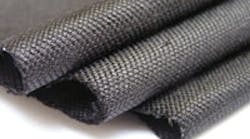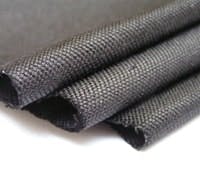Activated carbon cloth (ACC), a material composed of fine carbon fibers that have a similar diameter to powder, may offer significant benefits over powder alone for cleaning up toxic waste, say researchers at the University of Abertay, Dundee, Scotland.
The researchers, led by Professor David Bremner, Chair of Applied Environmental Science, found that ACC in conjunction with oxidants creates extremely reactive hydroxyl radicals. These are so unstable they instantly react with any pollutants, even at concentrations of just a few parts per million.
"There's been a lot of research into how activated carbon in powder or grain form can be used, but what we found is that using it as a fabric has a number of real advantages, [such as] its efficiency in adsorbing everything, its special structure and the fact that it is electrically conductive," says Bremner.
ACC is 100% activated carbon (AC). Its high level of pore development can be tailored for specific applications. Typically, ACC is predominantly microporous, but materials with levels of mesoporosity can be made, notes Carbon Filter Technology Ltd. (CFT), Kirriemiur, Scotland, (www.carbfilt.co.uk/), which supplied the fabric. CFT produces different versions of the material which already is used for medical clean rooms, air and water filtration and highly advanced wound dressings.
"The fabric has countless tiny pores which adsorb the organic molecules onto the surface via weak Van der Waals forces," explains Ian Johnson, the company's director. "The pollutants then react with the oxidant (ozone) on the surface of the carbon cloth, converting them into smaller molecules or even carbon dioxide and water. The carbon cloth is really acting as a catalyst, promoting the decomposition of the pollutants."
CFT cites a number of other advantages of ACC, including: high capacity and fast adsorption kinetics; suitability for gas or liquid streams; and ease of handling. The fabric can be cut, shaped and laminated.
"At the moment we are adsorbing pollutants onto the ACC and then using hydrogen peroxide and ozone along with the catalytic effect of the ACC to produce hydroxyl radicals. Fineness and texture of the cloth is not relevant but the size of the pores is important," says Bremner.
Further research will focus on optimizing the process, using different oxidants and looking at a variety of pollutants. Bremner also plans to investigate how to take advantage of the material's electrical conductivity. This work should take about three years, he reckons. Pilot-scale trials might begin in around four years and it will take at least six years before the technology is ready for industrial-scale demonstration, he adds.
Cost is a disadvantage. "ACC is more expensive than AC, but it is much more active and worth the difference for specialized applications," he says. Volume production might halve ACC cost, he believes.
For industrial applications, Bremner sees the most promising use in the removal and decomposition of persistent organic pollutants, endocrine disrupters and antibiotics from wastewater prior to reuse.
The fabric has not yet been tested to determine how many cycles it would last, but Bremner notes that it can readily be recycled by ultrasound or heating, and when combined with AC, the material can act as a mass adsorbent.
"ACC is very effective at adsorbing contaminants from vapors and from solution but it does get saturated eventually… It's best considered as a polishing filter rather than a mass adsorbent. AC can adsorb the masses, but always some would leak through. … Actually, the dream team for large scale adsorption is a combination of powdered activated carbon and ACC. Thus, a large bed of AC with an ACC component would be the perfect solution to ensure that no substance leaks through," says Bremner.



